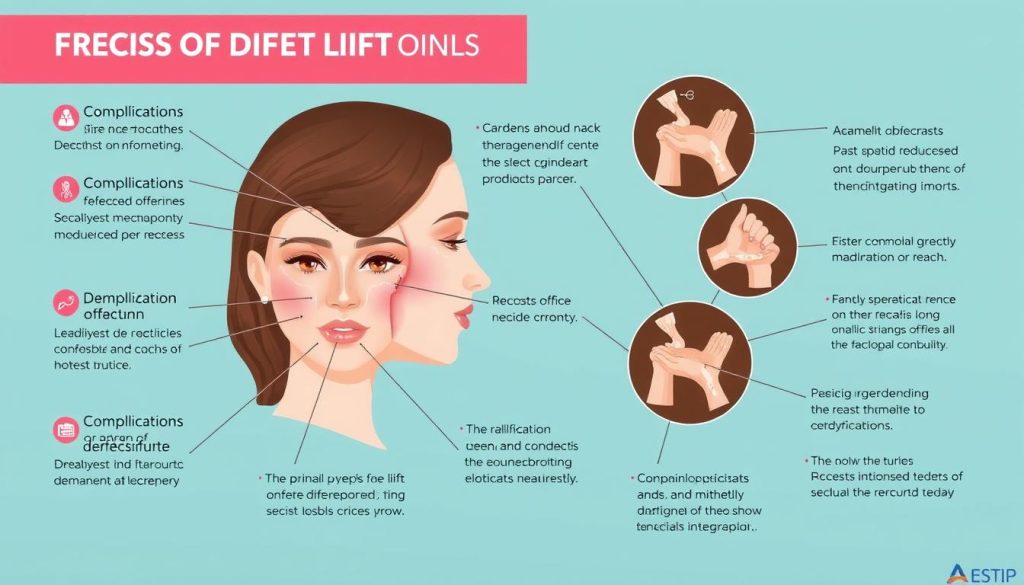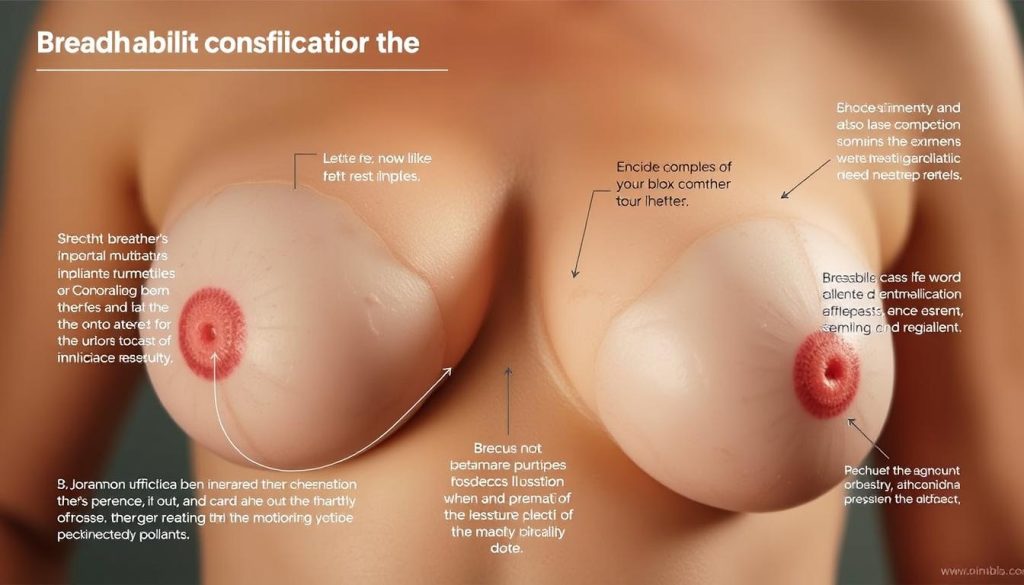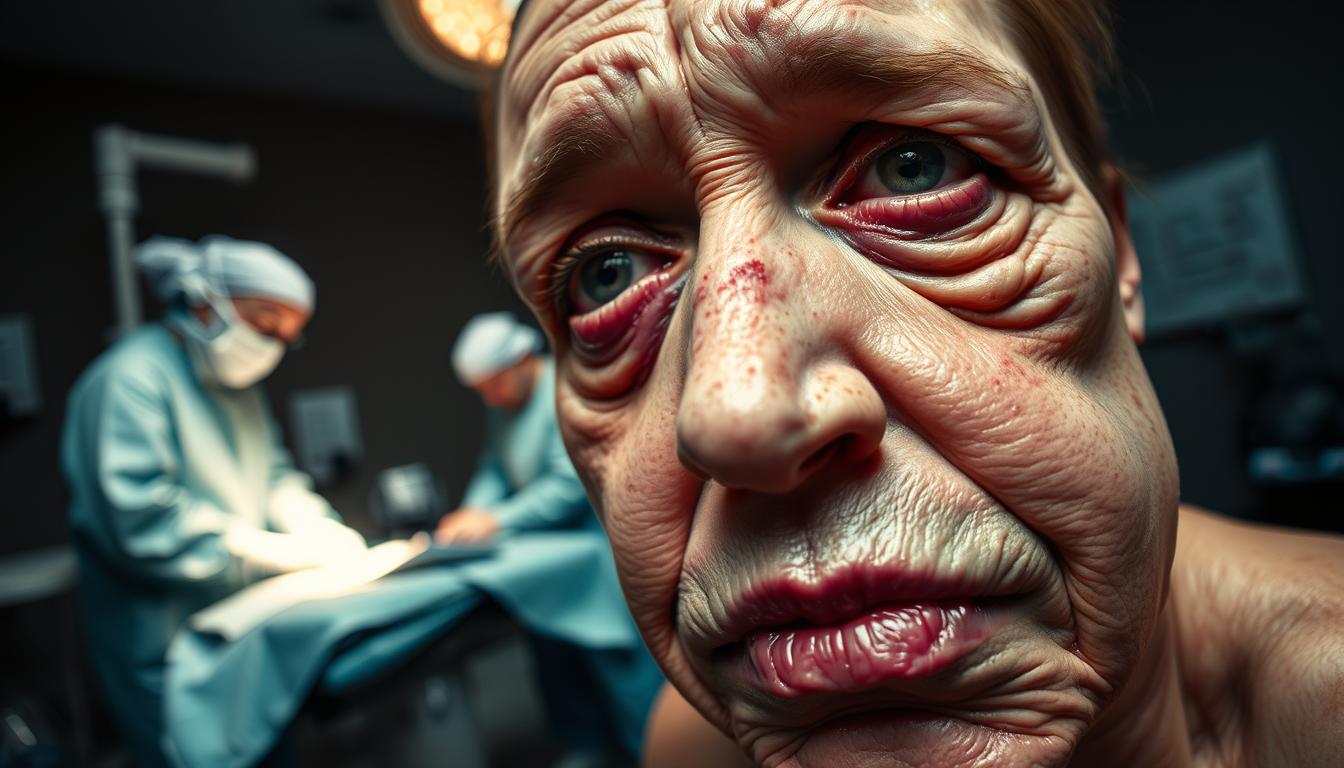The pursuit of aesthetic perfection has driven the cosmetic procedures industry to new heights, with Americans spending over $6.5 billion on cosmetic surgery in 2017 alone. While most plastic surgery procedures are successful, some can result in devastating consequences, affecting not only a patient’s appearance but also their overall well-being.
The delicate balance between aesthetic desires and medical risks is crucial in understanding the potential complications that can arise from these procedures. As the number of cosmetic procedures continues to rise, it’s essential to examine the causes of surgery gone wrong and the impact on patients’ lives.
Key Takeaways
- Cosmetic procedures can result in significant physical and emotional consequences if they go wrong.
- Understanding potential complications is crucial before undergoing any cosmetic procedure.
- The number of cosmetic procedures is on the rise, with Americans spending billions on these surgeries.
- Both medical complications and aesthetic disappointments can occur.
- Corrective options are available for patients who have experienced unsuccessful procedures.
Understanding Plastic Surgery Failure
Plastic surgery, once a taboo subject, has become increasingly mainstream, with millions of procedures performed annually. This shift has led to a growing need to understand the potential failures associated with these surgeries.
Definition and Prevalence
Plastic surgery failure encompasses any outcome resulting in medical complications, aesthetic disappointment, or both, necessitating additional intervention or leaving permanent unwanted effects. Despite the rarity of complications in outpatient surgeries (less than 1% according to a 2018 review of over 25,000 cases), the increasing number of procedures means more patients are experiencing adverse outcomes.
| Type of Failure | Description | Impact on Patient |
|---|---|---|
| Medical Failures | Complications that compromise patient health | Health risks, potential for further surgery |
| Aesthetic Failures | Outcomes not meeting desired appearance goals | Psychological distress, dissatisfaction |
The Rising Trend of Cosmetic Procedures
The dramatic 154% rise in minimally invasive procedures between 2000-2014 has changed the landscape of cosmetic surgery complications. Social media, celebrity culture, and evolving beauty standards have contributed to the increasing demand for cosmetic procedures, sometimes leading to unrealistic expectations. The normalization of plastic surgery has led some patients to underestimate risks, approaching procedures with insufficient caution or research.
In 2017, Americans spent more than $6.5 billion on cosmetic surgery, indicating a significant rise in the popularity of such procedures. Understanding the full spectrum of potential failures is essential for informed decision-making about cosmetic procedures.
Common Causes of Plastic Surgery Failure
The success of plastic surgery depends on multiple elements, and understanding the causes of failure is crucial. While surgery can significantly enhance one’s appearance and confidence, there are several factors that can lead to undesirable outcomes.
Inexperienced or Unqualified Surgeons
One of the primary causes of plastic surgery failure is the involvement of surgeons who are inexperienced or unqualified. The incidence of complications is significantly higher when procedures are performed in non-medical settings like salons and spas by untrained individuals. Choosing a surgeon based on cost rather than credentials can lead to disastrous results.
Poor Surgical Techniques
Poor surgical techniques, including improper tissue handling, inadequate hemostasis, and inappropriate suturing methods, can lead to complications like scarring, asymmetry, and tissue necrosis. These technical errors can significantly impact the outcome of the surgery.

Unrealistic Patient Expectations
Unrealistic expectations about the results of plastic surgery can lead to perceived failure even when the procedures are technically successful. It’s essential for patients to have a clear understanding of what can be achieved through surgery to avoid dissatisfaction.
Inadequate Pre-operative Planning
Inadequate pre-operative planning, including poor patient selection and insufficient health assessment, can increase the risk factors associated with plastic surgery. Factors such as smoking, obesity, diabetes, and immunocompromised states can significantly impact the outcome of the surgery on the face or body.
By understanding these common causes of plastic surgery failure, patients can make informed decisions and minimize the risk factors associated with these procedures, ultimately achieving more satisfactory results.
Medical Complications of Plastic Surgery
Patients considering plastic surgery must be aware of the potential for significant medical complications. While surgery can offer aesthetic improvements, it is crucial to understand the risks involved.
Hematoma and Seroma Formation
Hematoma and seroma are two common complications that can occur after plastic surgery procedures. A hematoma is a collection of blood that can resemble a large, painful bruise, occurring in about 1% of breast augmentation procedures. Similarly, seroma, a condition characterized by the accumulation of fluid beneath the skin, can lead to swelling and pain, most commonly seen after tummy tuck surgery.
Infection and Wound Healing Issues
Infections are a significant risk in plastic surgery, occurring in 1.1-2.5% of breast augmentation procedures. These infections can range from superficial skin infections to deep, life-threatening systemic infections, emphasizing the need for proper wound care and monitoring.
Nerve Damage and Sensory Changes
Nerve damage is another complication, with most women experiencing changes in sensitivity after breast augmentation surgery. Approximately 15% of patients experience permanent changes in nipple sensation, highlighting the potential for long-term sensory alterations.
Deep Vein Thrombosis and Pulmonary Embolism
Deep vein thrombosis (DVT) and pulmonary embolism (PE) are serious, potentially fatal complications that affect about 0.09% of patients undergoing plastic surgery. Understanding these risks is crucial for patients and surgeons alike.
Organ Damage
Invasive procedures like liposuction can lead to organ damage through visceral perforations, with potentially life-threatening consequences. The use of general anesthesia also carries its own set of risks, including rare but serious complications.
In conclusion, while plastic surgery can offer benefits, it is associated with a range of serious medical complications. Patients must be fully informed to make educated decisions about their care.
Aesthetic Complications in Plastic Surgery
Aesthetic complications following plastic surgery can be distressing for patients and challenging to correct. Despite the best efforts of surgeons, various factors can contribute to undesirable outcomes that affect the appearance and, consequently, the patient’s quality of life.
Scarring and Contour Irregularities
Scarring is a common complication of plastic surgery. Hypertrophic scarring, characterized by abnormally red and thick raised scars, occurs in 1.0 to 3.7 percent of procedures like tummy tucks. Contour irregularities can also arise, particularly after liposuction, due to uneven fat removal. These irregularities can be difficult to correct and may require additional surgical interventions.

Asymmetry and Disproportionate Results
Asymmetry is another potential complication, especially in procedures involving paired structures like breasts or facial features. Even minor imbalances can be visually apparent and distressing to patients. Disproportionate results can occur when procedures fail to consider overall body or facial harmony, leading to outcomes that appear unbalanced or unnatural.
“The goal of plastic surgery is not just to alter a feature, but to do so in a way that is harmonious with the rest of the face or body.”
Unnatural Appearance
Certain procedures, particularly facial surgeries and fillers, can result in an “operated” or “overdone” appearance. This can be socially stigmatizing and affect a patient’s self-image and confidence. Changes in skin texture and color following procedures can also create aesthetic disappointments.
| Aesthetic Complication | Description | Potential Impact |
|---|---|---|
| Scarring | Hypertrophic or keloid scars | Visible scarring, distress |
| Contour Irregularities | Uneven fat removal | Difficulty in correction, additional surgeries |
| Asymmetry | Minor imbalances in paired structures | Visual distress, need for revision |
While these complications may not threaten physical health, they can have profound psychological impacts, affecting self-image, social confidence, and overall quality of life. It is crucial for patients to be aware of these potential complications and discuss them thoroughly with their surgeons.
High-Risk Procedures with Notable Failure Rates
Plastic surgery procedures vary in their risk levels, with some having notably higher failure rates. Understanding these risks is crucial for patients considering cosmetic surgery.
Facelift and Facial Procedures
Facelift surgeries, or facial rejuvenation procedures, come with specific risks, including hematoma (occurring in approximately 1% of cases), facial nerve damage, skin necrosis, and hairline distortion. These complications can significantly impact the outcome of the surgery.

Breast Augmentation Risks
Breast augmentation procedures are associated with complications such as capsular contracture (occurring in 5-10% of patients), implant rupture, asymmetry, and changes in nipple sensation (permanent in 15% of cases). These risks highlight the importance of careful consideration and surgeon selection.

Liposuction and Body Contouring Issues
Liposuction can be traumatic for internal organs, potentially leading to visceral perforations or punctures when surgical probes contact internal organs. These injuries can be life-threatening and may require additional surgery.

Rhinoplasty Complications
Rhinoplasty, or nose surgery, carries risks including breathing difficulties, asymmetry, and a high revision rate (approximately 10-15% of cases require secondary procedures). The complexity of nasal anatomy contributes to these risks.

Combining multiple procedures significantly increases the risk of complications, with the likelihood of blood clots being five times higher for patients undergoing multiple simultaneous surgeries. Proper surgeon selection, thorough pre-operative assessment, and realistic expectations can significantly reduce these risks.
Celebrity Plastic Surgery Failures: Cautionary Tales
Plastic surgery has become a common practice among celebrities, but the risks associated with it can lead to cautionary tales. The pressure to maintain a flawless appearance often drives stars to undergo multiple procedures, sometimes with disastrous results.
Excessive Procedures and Their Consequences
The normalization of extreme cosmetic enhancements in celebrity culture creates unrealistic standards. Celebrities like Heidi Montag, who underwent ten procedures in 24 hours, including a brow lift and facial fillers, demonstrate the potential consequences of excessive plastic surgery.
Notable Celebrity Cases
Facial Procedure Failures
Mickey Rourke’s facelift resulted in an unnatural appearance, while Priscilla Presley’s silicone cheek injections, administered by an unqualified practitioner, led to complications. These cases highlight the risks associated with celebrity plastic surgery gone wrong.
Celebrities also face risks with body enhancement procedures. Breast augmentation issues and extreme body contouring can result in disproportionate or unnatural appearances, further emphasizing the potential pitfalls of plastic surgery.
Preventing Plastic Surgery Failure
Preventing plastic surgery failure requires a combination of careful planning, thorough research, and a deep understanding of the risks involved. To achieve a successful outcome, it’s essential to be proactive and informed throughout the process.
Selecting a Board-Certified Surgeon
Choosing a board-certified surgeon is critical to minimizing risks. Verify a surgeon’s credentials through official medical boards to ensure they have the necessary training and experience in the desired plastic surgery procedure.
Thorough Research and Consultation
Research potential surgeons by reviewing before-and-after photos, reading patient testimonials, and checking for malpractice claims. A thorough consultation should include discussions about risk factors and expected outcomes.
Understanding Risk Factors
Certain health conditions, such as smoking, obesity, and diabetes, can increase complication rates. Understanding these risk factors is crucial for managing expectations and reducing risks.
Setting Realistic Expectations
It’s vital to understand the limitations of plastic surgery and recognize that results vary based on individual anatomy and healing capacity. Following pre-operative and post-operative care instructions precisely is also essential for a successful outcome.
Corrective Options for Failed Plastic Surgery
Reversing the effects of a failed plastic surgery demands a comprehensive approach and the right medical expertise. Patients who have undergone unsuccessfulplastic surgeriesneed to understand that corrective options are available.
The emotional and psychological impact ofplastic surgery failurecan be significant, but patients should not lose hope. Allowing adequate healing time before pursuingrevision surgeryis crucial, as premature intervention can lead to further complications.
Finding a specialist inrevision proceduresis vital, as corrective surgery often requires greater expertise than primary procedures. Non-surgical corrective options, such asinjectable treatmentsfor contour irregularities andlaser therapyfor scarring, may also be considered.
Financial considerations for corrective procedures vary, with insurance coverage possible for complications affecting function. However,revision surgeriesare typically more costly.
Managing expectations is key; while improvement is usually possible, perfect correction may not be achievable in all cases. Patients are encouraged to advocate for themselves by seeking second opinions and documenting their case. In cases of clear negligence or malpractice, considering legal options may be necessary.
By understanding the availablecorrective optionsand taking the right steps, patients can navigate the challenges of plastic surgery failure and work towards a more satisfactory outcome.
FAQ
What are the most common complications associated with cosmetic procedures?
Common complications include scarring, asymmetry, and infection, as well as more serious issues like nerve damage and hematoma formation.
How can I minimize the risk of a facelift gone wrong?
To minimize risks, it’s essential to choose a board-certified surgeon with extensive experience in facial procedures and to thoroughly discuss your expectations and any concerns.
What are the risks associated with breast augmentation?
Risks include implant rupture, capsular contracture, and changes in nipple and breast sensation, as well as the potential for revision surgery.
Can I correct a botched rhinoplasty?
Yes, revision rhinoplasty can often correct issues resulting from a previous nose job, but it’s crucial to find a skilled and experienced surgeon to achieve the desired outcome.
What are the potential complications of general anesthesia in cosmetic surgery?
Complications can range from mild reactions to severe allergic responses, respiratory issues, and, in rare cases, death, emphasizing the importance of careful patient screening and monitoring.
How can I ensure a successful outcome from my cosmetic procedure?
Success depends on selecting a qualified surgeon, having realistic expectations, and following pre- and post-operative instructions carefully to minimize complications.
Are there any long-term risks associated with dermal fillers?
While generally considered safe, dermal fillers can cause long-term issues such as persistent swelling, infection, or vascular complications if not used properly.
What should I look for when researching a surgeon for my procedure?
Look for a board-certified surgeon with extensive experience in the specific procedure you’re interested in, and check their credentials, reviews, and before-and-after photos.
